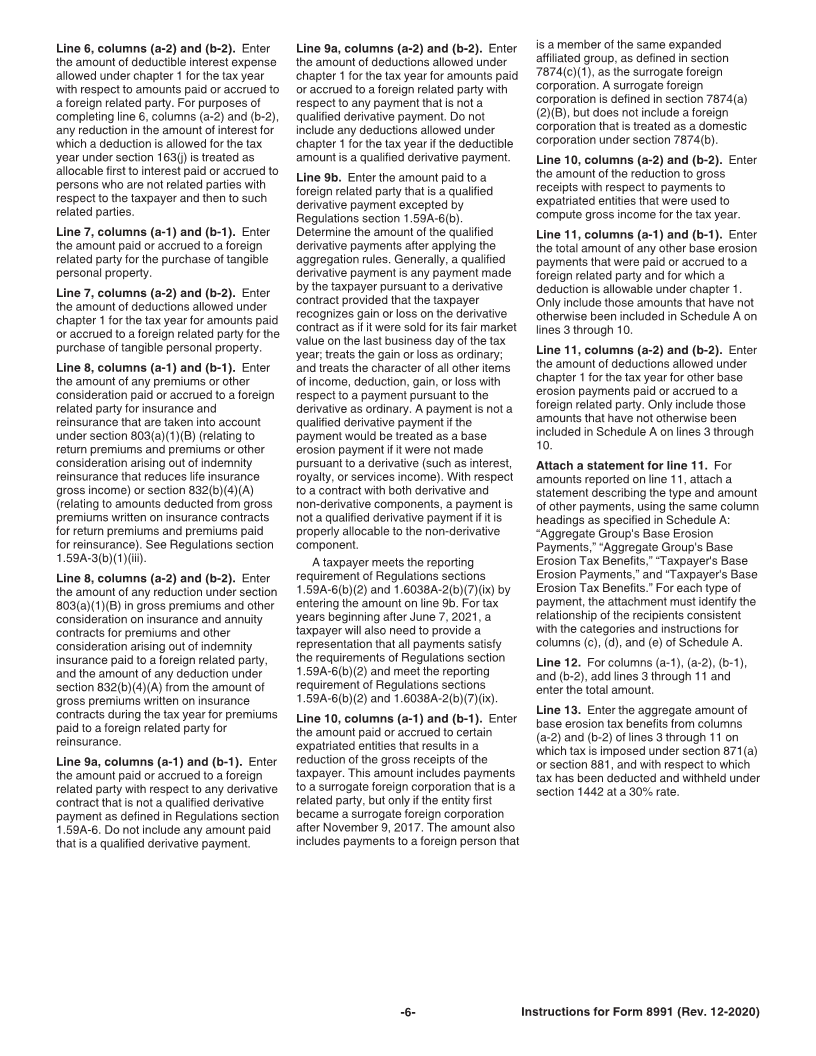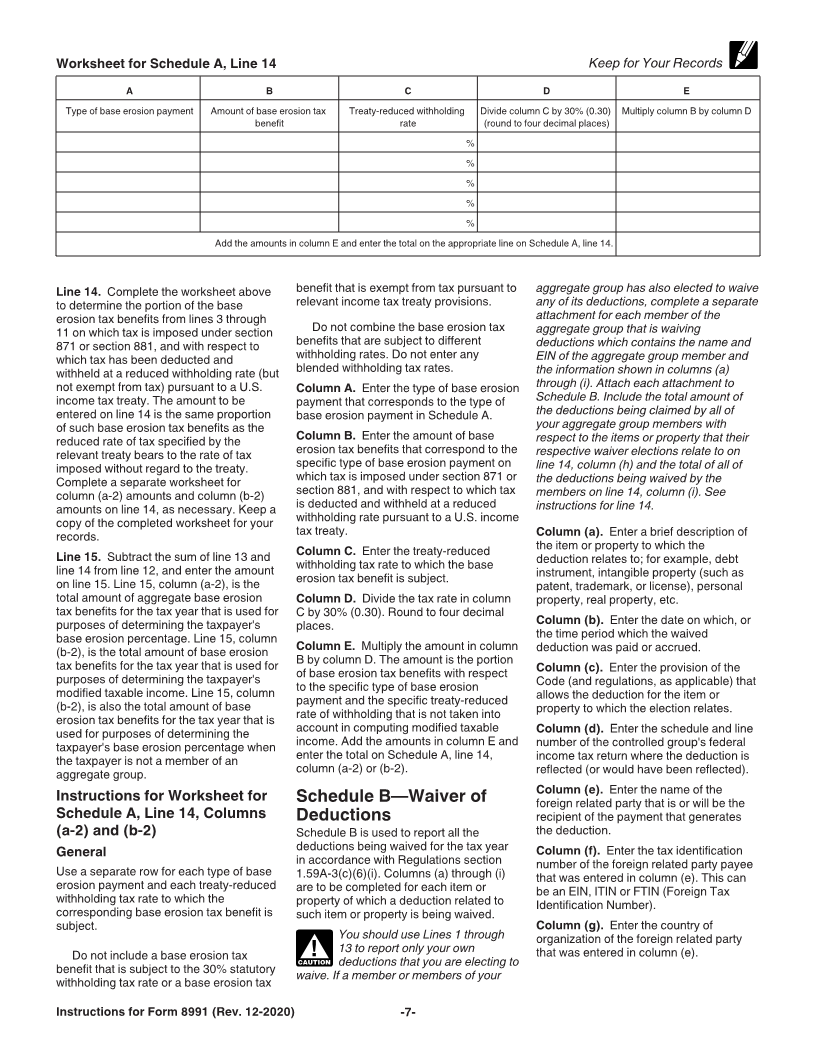- 9 -

Enlarge image
|
Page 8 of 8 Fileid: … ns/I8991/202101/A/XML/Cycle07/source 10:59 - 22-Dec-2020
The type and rule above prints on all proofs including departmental reproduction proofs. MUST be removed before printing.
Column (h). For each item or property equals the available credit for increasing Line 9. Enter the total amount of section
reported under columns (a) through (g), research activities in the tax year. 45 credit shown on Form 3800, lines 1f
enter the amount of the deduction claimed Line 3. Enter only the portion of the and 4e, “Renewable electricity, refined
on the tax return (after the waiver available credit for increasing research coal, and Indian coal production (Form
indicated in column (i)). activities which was included on Form 8835),” of all Parts III, with box A, B, C, or
Column (i). For each item or property 3800, Part II, line 38, and used against D checked (other than any amount
reported under columns (a) through (g), regular tax liability. You must apply the allocable to refined coal and Indian coal
enter the amount of the deduction being general rules and the ordering rules for production). This total equals the available
waived. use of general business credits from the credit for renewable electricity production
Instructions for Form 3800. The in the tax year.
Line 14. If additional space is necessary, Instructions for Form 3800 provide that Line 10. Enter only the total amount of
complete and attach a separate worksheet credits reported on Form 3800 are treated investment credit allocable to the section
with the same information as shown under as used on a first-in, first-out basis by 48 energy credit shown on line 4a,
columns (a) through (i) for each additional offsetting the earliest earned credits first. “Investment (Form 3468, Part III)” of all
item or property. Enter the total of Therefore, the order in which the credits Parts III, Form 3800, with box A, B, C, or D
deductions claimed for the tax year on are used in any tax year is: checked. The section 48 energy credit
line 14, column (h) and the total of • Carryforwards to that year, the earliest portion of the amount in Part III, line 4a,
deductions waived on line 14, column (i). ones first; equals the sum of the amounts reported in
Also include on this line the total of • The general business credit earned in Form 3468, Part III, Energy credit, on lines
deductions being claimed (column (h)) that year; and 12a, 12b, 12c, 12d, 12g, 12j, 12m, 12p,
and waived (column (i)) from other • The carryback to that year. 12s, 12v, 12x, 12y, 12z, 12aa, 12bb, 12cc,
taxpayers that are members of your If your general business credits exceed 12dd, 12ee, 12ff, and 12gg. This total
aggregate group, if applicable. your tax liability limit, the credits are used equals the available investment credit
in the order as they are listed in section properly allocable to the energy credit in
Schedule C—Credits 38(b). Although general business credits the tax year.
Reducing Regular Tax are aggregated on Form 3800, you should
Line 11. Enter only the portion of the
have a separate record of each credit.
Liability in Computing available applicable credits which was
Line 5. Section 59A(b)(1)(B)(ii)(II) limits included on Form 3800, Part II, line 38,
Base Erosion Minimum the allowable adjustment for applicable and used against regular tax liability. This
Tax Amount (BEMTA) section 38 credits to 80% of the lesser of represents the amount of applicable
applicable section 38 credits or the credits allowed in the current year. Refer
Part I—Credits Allowed Against BEMTA computed without the adjustment to the ordering rules described in the
Regular Tax for applicable section 38 credits computed earlier instructions for Schedule C, line 3.
in Part III.
Line 1. You must enter the total credits Part III—BEMTA Determined
allowed against your regular tax liability in Part II—Applicable Section 38 Without Adjustment for
the tax year, except for credits allowed Credits Applicable Section 38 Credits
under sections 33, 37, and 53. Total
credits include the sum of all credits Line 8. Enter the total amount of credit Line 15. Subtract line 14 from line 13. If
shown on Form 1120 or other applicable shown on line 1d, “Low-income housing zero or less, enter “-0-.”
return. (Form 8586, Part I only),” and line 4d,
“Low-income housing (Form 8586, Part Line 16. You must compute the BEMTA
Line 2. Enter the total amount of credit for II),” of all Parts III, Form 3800, with box A, without adjustment for applicable section
increasing research activities reported on B, C, or D checked. This total equals the 38 credits to allow computation of the
line 1c, “Increasing research activities available credit for low-income housing in limitation of applicable section 38 credits
(Form 6765),” of all Parts III, Form 3800, the tax year. on lines 4 and 5 of Part I.
with box A, B, C, or D checked. This total
Paperwork Reduction Act Notice. We ask for the information on this form to carry out the Internal Revenue laws of the United
States. You are required to give us the information. We need it to ensure that you are complying with these laws and to allow us to
figure and collect the right amount of tax.
You are not required to provide the information requested on a form that is subject to the Paperwork Reduction Act unless the form
displays a valid OMB control number. Books or records relating to a form or its instructions must be retained as long as their contents
may become material in the administration of any Internal Revenue law. Generally, tax returns and return information are confidential,
as required by section 6103.
The time needed to complete and file this form will vary depending on individual circumstances. The estimated burden for business
taxpayers filing this form is approved under OMB control number 1545-0123 and is included in the estimates shown in the instructions
for their business income tax return.
-8- Instructions for Form 8991 (Rev. 12-2020)
|








